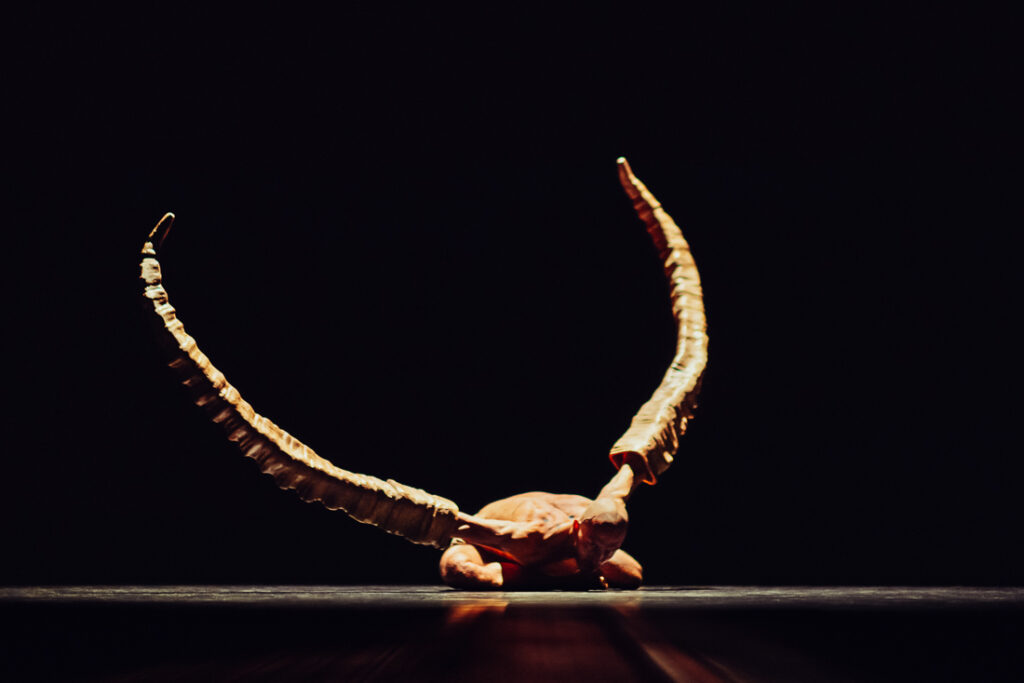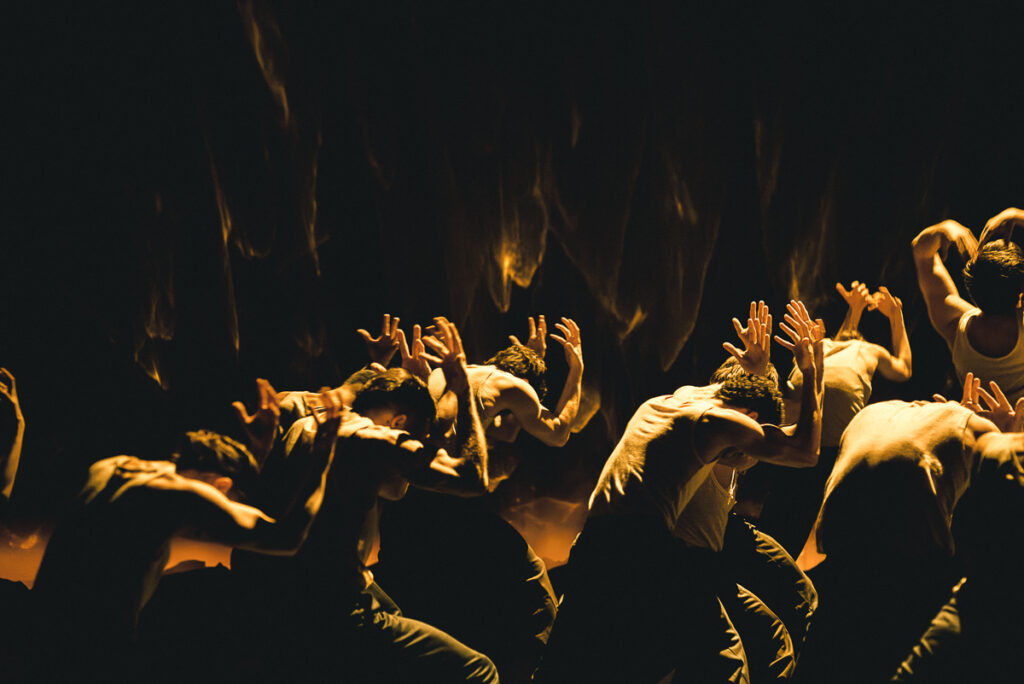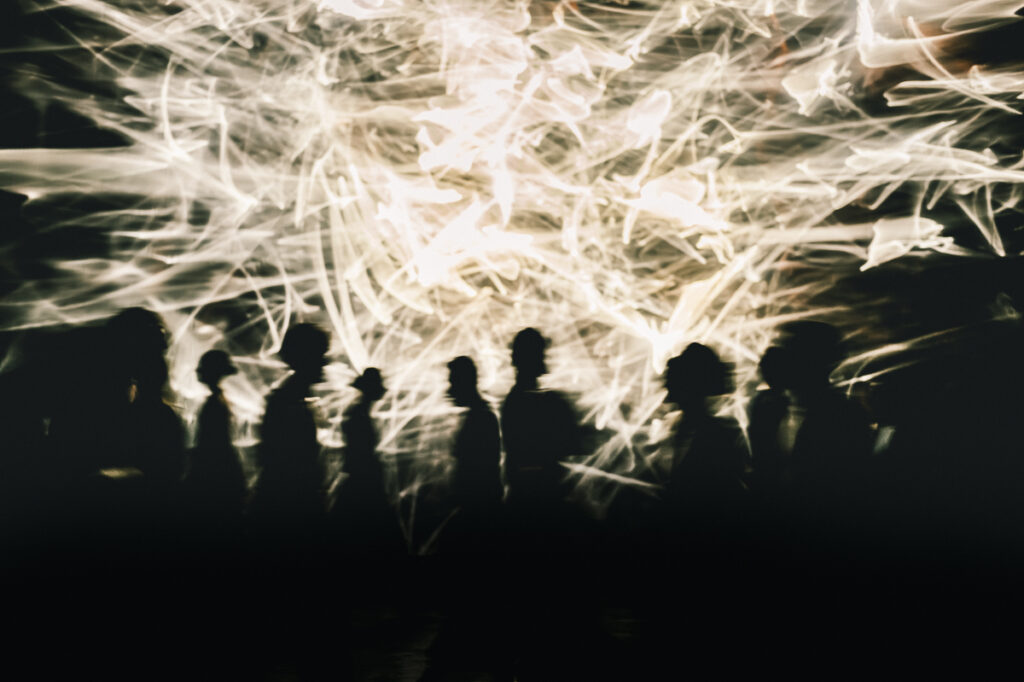Figures in Extinction Review 4*

Crystal Pite, Simon McBurney and NDT collaborate in Figures in Extinction, a plea for the environment and humanity
This article was first published on London Unattached
Figures in Extinction is a massive work in three acts that blends dance, theatre, music, the spoken word, video and puppetry and runs over the best part of three hours (including two intervals); but in the end, it boils down to a heartfelt, pressing plea for connection – connection between humans and nature, between human and human and, ultimately, between the living and the dead.
It’s a collaboration between Canadian choreographer Crystal Pite, British theatre director and founder of Complicité Simon McBurney and Nederlands Dans Theater (NDT), with crucial input from a large team to technical wizards.
To quote Crystal Pite, “A yearning for connection runs like a luminous thread through the whole show.”

Released in separate segments starting with Act I, Figures in Extinction [1.0], the list, in 2022, the full work had its world premiere at the Manchester Aviva Studios, which co-commissioned it, earlier this year and has now arrived at Sadler’s Wells for a much-anticipated short run.
Figures in Extinction [1.0], the list
Act I is perhaps the most cohesive of the three. It focuses on the animals, plants, and natural features that have become extinct due to human action over the past century.
The first extinct animal portrayed provides a memorable image: a single dancer, his arms encased in outsize curved, ridged horns, represents the majestic – and now extinct – Pyrenean Ibex (pictured top).
He is part of a long list of natural losses: Bachman’s Warbler, Spider Orchid, South Selkirk Caribou, Helheim Glacier… the list spoken on voice over, goes heartbreakingly on, each number represented by allusive sound and movement, so that birdsong accompanies a woman whose fluttering hands are like small bird’s wings; a group of hunched dancers slowly cross the stage like caribou patiently making their way across the frozen wastes of the north; bodies come together to form a mountain that rises and suddenly collapses portraying the disappearance of the glacier.
A child’s voice is heard: “Where have they gone? Have they gone forever?” adding almost unbearable poignancy to this litany of irretrievable loss.
Enter the Climate Change Denier, an excitable, vaudevillian character whose lip-synched message is all too familiar, but chilling nonetheless: climate change, he asserts, is “the greatest hoax ever perpetrated on mankind”.
Yet the list of losses goes inexorably on.
Figures in Extinction [2.0], but when you come to the humans
Act II, but then you come to the humans, shifts the focus. Now humans take centre stage, particularly their isolation from each other, created to a large extent by an over-reliance on technology.
AI figures projected on the backcloth smile alluringly; a man at the end of this tether screams into a phone, “Let me speak to a person!’
A group of dancers in severe black suits sit totally immobile. The child’s voice is heard again: “Why aren’t they moving?” When they do, though, it’s to grab their phones, each individual entirely fixated on their own little screen.

The voice-over now quotes extensively from the work of the philosopher and neuroscientist Iain McGilchrist, describing the two hemispheres of the brain and their functions, while the dancers divide into groups representing each hemisphere.
At her best when moving large groups on the stage, Crystal Pite is one of the few choreographers who can create dance that responds naturally to the spoken word, something which is present throughout much of her oeuvre, most prominently, perhaps, in The Statement, a critique of faceless bureaucracies, created for NDT in 2016 and performed entirely to a spoken text.
Her choreography throughout Figures in Extinction springs from the words as easily as it does from music, and tallies perfectly with McBurney’s input, dictated by his notion of theatre as an ever-expanding hybrid medium.
Intuition, we learn, is a gift; reason is the servant. The tragedy, McGilchrist argues, is that our society privileges the servant over the gift, so that humanity’s connection with the nature of which it is an inseparable part is lost or ignored, as indeed is the connection between individual humans.
Figures in Extinction [3.0], Requiem
Act III, Requiem, considers death. Lined up downstage, the dancers are asked to talk about their grandparents; a flat hand slowly touching the ground indicates they are dead.
A woman lies dying in a hospital bed. Two orderlies go about changing the bed linen in a way so professionally detached as to be almost comical. The family gathers together, discussing the stages of grief.
They see death as a separation, but in reality, Act III posits, death and life are inseparable. The final scene sees the dancers moving against a feathery ectoplasm projected onto the backcloth, life and death coexisting in harmony.

Tom Visser’s characteristically eloquent lighting enhanced every scene; Owen Belton’s original score, combined with Benjamin Grant’s sound design, provided a seamless aural bed for the movement on stage; Pite’s partner and regular set designer, Jay Gower Taylor and Michael Levine created sparing but atmospheric sets.
And the wonderful dancers of NDT carried the work with their usual compelling performances.
Figures in Extinction is a timely and important piece that totally fulfils art’s remit to deal with pressing contemporary issues without lowering aesthetic standards. I found Act III rather lost its focus towards the end and would gain from being tightened a little, but that is my only criticism.
© Teresa Guerreiro
(Banner imag: NDT1, Figures in Extinction [1.0] Photo: Rajhi Rezvani)
Figures in Extinction was at Sadler’s Wells 05 to 08 November 2025
